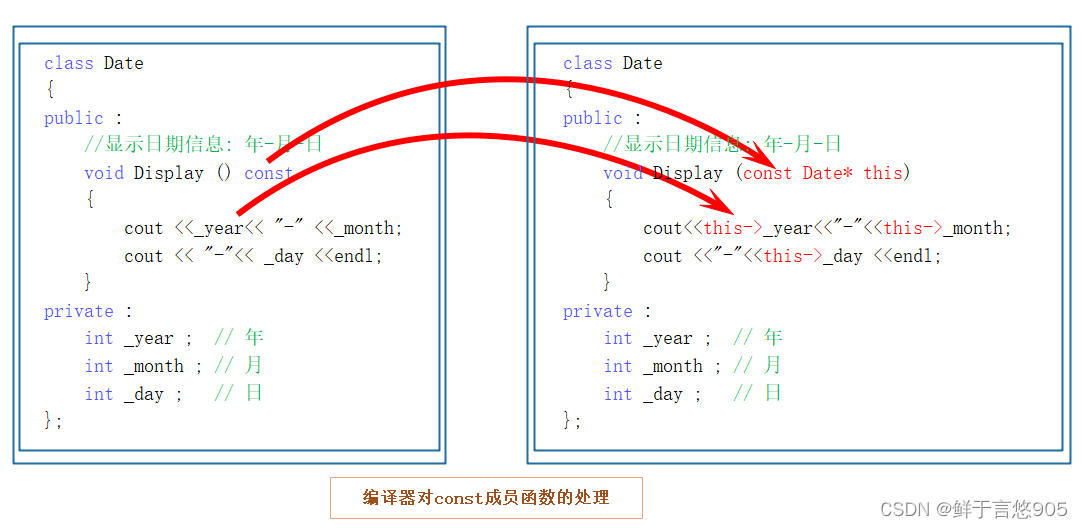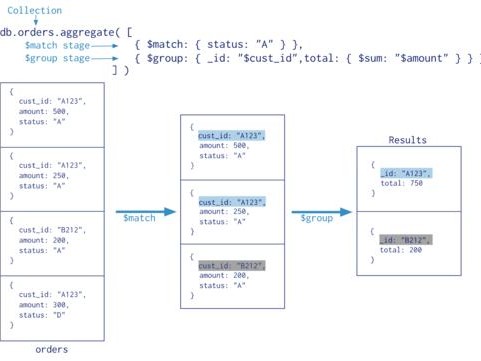const与取地址重载
- 前言
- 一、const
- 正常用法
- const成员函数
- 问题
- `const`对象可以调用非`const`成员函数吗
- 非`const`对象可以调用`const`成员函数吗
- `const`成员函数内可以调用其它的非`const`成员函数吗
- 非`const`成员函数内可以调用其它的`const`成员函数吗
- 假如函数出现多个变量,const修饰的是谁
- 总结
- 二、取地址及const取地址操作符重载
- 概念
- 示例
前言
类的6个默认成员函数:如果一个类中什么成员都没有,简称为空类。
空类中真的什么都没有吗?并不是,任何类在什么都不写时,编译器会自动生成以下6个默认成员函数。
默认成员函数:用户没有显式实现,编译器会生成的成员函数称为默认成员函数。
class Date {};
一、const
正常用法
在C++中,可以使用const关键字来声明一个常量成员。常量成员是指在类中声明的成员变量被标记为只读,即不能在类的方法中进行修改。常量成员的值在对象创建时被初始化,并且在对象的整个生命周期中保持不变。
常量成员的声明方式为在成员变量的类型前加上const关键字。例如:
class MyClass { public: const int myConst = 10; // 常量成员的声明和初始化 };在上述示例中,myConst被声明为一个常量成员,其初始值为10。
const成员函数
除了上面的这种用法外,C++在类里定义了新的const用法,将const修饰的“成员函数”称之为const成员函数,const修饰类成员函数,实际修饰该成员函数隐含的this指针,表明在该成员函数中不能对类的任何成员进行修改。

我们来看看下面的代码
class Date { public: Date(int year, int month, int day) { _year = year; _month = month; _day = day; } void Print() { cout cout Date d1(2022, 1, 13); d1.Print(); const Date d2(2022, 1, 13); d2.Print(); } public: void nonConstFunc() { // 可以修改对象状态的非const成员函数 } void constFunc() const { // 不能修改对象状态的const成员函数 } }; int main() { const MyClass obj; obj.constFunc(); // 可以调用const成员函数 // obj.nonConstFunc(); // 错误,不能调用非const成员函数 return 0; } public: void nonConstFunc() { // 可以修改对象状态的非const成员函数 } void constFunc() const { // 不能修改对象状态的const成员函数 } }; int main() { MyClass obj; obj.constFunc(); // 可以调用const成员函数 obj.nonConstFunc(); // 也可以调用非const成员函数 return 0; } public: void nonConstFunc() { // 可以修改对象状态的非const成员函数 } void constFunc() const { // 不能修改对象状态的const成员函数 nonConstFunc(); // 错误! const成员函数不能调用非const成员函数 } }; int main() { MyClass obj; obj.constFunc(); return 0; } const_cast public: void nonConstFunc() { // 可以修改对象状态的非const成员函数 constFunc(); // 可以调用const成员函数 } void constFunc() const { // 不能修改对象状态的const成员函数 } }; int main() { MyClass obj; obj.nonConstFunc(); // 调用非const成员函数,它内部调用了const成员函数 return 0; } public: void myFunction(int a, const int b) const; private: int m_variable; }; public: Date* operator&() { return this; } const Date* operator&()const { return this; } private: int _year; // 年 int _month; // 月 int _day; // 日 }; private: int value; public: MyClass(int value) : value(value) {} int* operator&() { std::cout std::cout MyClass obj(10); int* ptr1 = &obj; // 调用非const版本的operator& const int* ptr2 = &obj; // 调用const版本的operator& return 0; }









